
Can you believe it? I’m hosting this months Baker’s Challenge!! For my turn as hostess extraordinaire, I have chosen the gorgeous Neapolitan pastry, sfogliatelle. You might recognize them as the clam shaped pastry with hundreds of layers. They are filled with a semolina-ricotta mixture that has added candied orange peel and a touch of cinnamon, served hot out of the oven (though I have eaten my fair share of room temperature ones).Here is a very interesting article on the history of this beloved pastry.
Growing up in Long Island, New York, it is virtually impossible to get away from Italian food.I think the natural progression for many Italian immigrants was to go from Italy, to Ellis Island, to Brooklyn, and then to Long Island. For me though, my real love of Italian food, (and cooking in general) came later when I lived in Manhattan with my then boyfriend. We lived together for 10 years and the large family feasts at his parents Long Island home were memorable. We would arrive around noon and continue until late in the night with everyone pitching in with the cooking at one point or another. I really learned that the meal was as much about gathering together as it was about eating. Luckily for me, I am still extremely close with him and his family. He now even owns an Italian wine store in Brooklyn to go with the great food. I now follow this tradition with my husband by having our friends over as much as possible to enjoy their wit as well as food.
I wanted to choose something that would be a challenge; not only to you but for me as well. And I was right on point. I won’t lie to you, the first two times I made these it was a disaster. The third time was the charm and now they almost seem easy to make. The sfogliatelle ricci can be made over a period of days, if this makes it easier for you. I tend to like to make things in stages myself but you could also make this over the course of a long day. Keep in mind that you must chill the dough at various points before baking.
There are two main Italian versions of sfogliatelle. The first is sfogliatelle ricci (or Napoletane) and this is the crispy multilayered version. The second is sfogliatelle frolle, a tender almost cakey version covered in a soft pie crust like shell.
The American version goes by the name “lobster tail” and is a larger shell filled with a creme diplomat (pastry cream mixed with whipped cream) after it is baked. The dough is the same as Ricci but a dollop of pate a choux pastry is placed in the center of the shell before baking. This puffs up the core of the shell so that you can pipe in the creamy filling afterword. In one word, divine!
I am providing recipes for homemade ricotta cheese (so easy and so delicious), candied orange peel, sfogliatelle ricci and frolle dough. You must make the homemade cheese or the candied peel and at least one version of the sfogliatelle. Please experiment with filling flavors. I think chocolate ricotta with finely chopped pears would be lovely…The filling provided for the American Lobster Tail is a diplomat cream but I personally love marscapone mixed whipped cream. Again, amaze and inspire me. While I believe that the ricci version can only be made using a pasta roller, I hope that many out there prove me wrong!
Have Fun and Bake On!
Recipe Source:
The pastry dough recipe is from Great Italian Desserts by Nick Malgieri. Unfortunately this book is out of print but you can still find used copies online or if your lucky, your local library. The Ricotta Cheese recipe is from Luscious Creamy Desserts by Lori Longbotham. The method for making the lobster tails is from the Cake Boss You Tube video. The Pastry cream recipe is from Martha Stewart (but feel free to use any pastry cream recipe)
Dairy Free Ricotta Cheese: http://low-cholesterol.food.com/recipe/ricotta-cheese-substitute-vegan-gluten-free-447217
http://cassidyscraveablecreations.com/2012/09/ricotta-cheese-dairy-soy-nut-free.html
Equipment needed
Pasta machine to roll out the dough (this is for the Ricce and Lobster Tail)
Stand mixer with paddle and whisk attachments or hand-held mixer. You can make the dough in a bowl with a wooden spoon. If you choose to make the French Cream for the lobster tail you can whip the heavy cream by hand with a whisk
food processor (optional)
Whisk
rolling-pin
Grater for lemon and orange zest
Large pot to make the cheese
large glass or ceramic bowl
large strainer/colander
cheesecloth (I have used paper coffee liners as well)
medium saucepan for semolina
small bowl for butter/shortening mixture
Saucepan for pastry cream
Bowl for Pastry cream
Pastry Brush
Plastic wrap/cling film
parchment paper
baking sheets
cutting board
1/2 inch round pastry tip
Cooling rack
Fresh Ricotta Cheese (makes 2 cups)
8 Cups (1/2 gallon/64 oz/2 litre/4 pints) Whole Milk (or goats milk)
1 Cup (8 oz/250 ml) heavy whipping cream
1/2 tsp salt
3 Tablespoons fresh lemon juice
Line a large colander or strainer with 2 layers of cheesecloth that has been lightly dampened over a large glass; set aside.
Pour the whole milk, heavy cream and salt into a large pot and bring to a boil over medium heat, whisking occasionally. reduce the heat, add the fresh lemon juice and stir/whisk continuously for 2-3 minutes. The mixture will curdle, which is exactly what it is supposed to do. 
Pour this into the cheesecloth lined strainer and let it drain for about 1 hour or until it comes to room temperature. At this point you can scrape the ricotta from the cheesecloth into a container and refrigerate for up to 2 days. The liquid in the bowl is the liquid whey, a very nutritional and tasty leftover byproduct from making cheese. It is excellent to use instead of water when baking bread, or adding it to soup stock. I love the stuff and never discard it. Here is an excellent article on the wonders of whey!

Semolina-Ricotta Filling
This type is used for both the Ricci and the Frolle versions
5 minutes to make plus about 2 hours to chill
1 Cup (8 oz/250 ml) milk
1/2 cup granulated sugar
2/3 Cup fine semolina or cream of wheat (I have tried both and personally like the semolina version)
1 1/2 Cups whole milk ricotta, preferably fresh (see above)
2 large egg yolks
2 teaspoons pure vanilla extract (or the seeds of one pod and 1 tsp extract)
1/4 teaspoon ground cinnamon
1/3 cup candied orange peel (commercial or home-made)
zest of 1 lemon
Combine the milk and the sugar in a medium saucepan. Bring to a boil, lower the heat and slowly add the semolina (or cream of wheat), whisking quickly as to avoid any lumps. Cook, stirring often, until the mixture is smooth and thick, about 2 minutes. Spread the mixture onto a lined baking sheet, about 1/2 inch, to cool. When cool, break into pieces and place into the bowl of your stand mixer, fitted with the paddle attachment (or a food processor), and add the ricotta cheese, egg yolks, vanilla and cinnamon. Beat until very smooth and creamy. Stir in the candied orange peel and lemon zest. (Maybe even some mini chocolate chips? Or pistachios??mmmm…I can’t wait to see what you come up with)
Scrape into a container, place plastic wrap directly onto the surface and refrigerate until needed (up to 2 days)

Sfogliatelle Ricci
You will need a large/long workspace for this. I used my dining room table for this though I am sure someone will be more creative with limited space!
4 minutes to make the dough
10 minutes to condition the dough in the pasta roller
2 hours chilling
35 minutes to roll the dough
2 hours additional chilling
Dough
3 Cups (12 3/4 oz/ 334 g) all-purpose flour
1 teaspoon salt
3/4 cup (6.2 oz/ 175 g) warm water (about 100F)
4 oz lard (I used Crisco butter flavored shortening)
4 oz (1 stick/1/2 cup) unsalted butter, softened
Combine the flour and salt in a large mixing bowl and stir in the water, or use your standing mixer with the paddle attachment for this.. The dough will be very dry. If you feel absolutely compelled, add an extra teaspoon of water but it is supposed to be very dry. Turn this out onto a clean work surface and knead the dough together, bringing in all the dry bits. At this point get your pasta roller out and ready. Roll out the dough to about 1/3 inch and pass through your pasta machine at the widest setting. I find it much easier to cut my dough in half and work 1/2 at a time for this step. Fold the dough in half after each pass also change the direction of the dough occasionally. After about 15 passes the dough should be very smooth. Knead the dough back into a ball and wrap in plastic wrap. Refrigerate and rest the dough for at 2 hours ,or overnight.

Beat the lard/shortening and butter together in your mixing bowl until very fluffy. Make sure it is thoroughly combined. Place into a bowl and set on the workspace in easy reaching distance.

Remove the dough from the refrigerator and divide it into 4 equal pieces. Working with one piece of dough at a time (cover the other pieces with a towel or plastic wrap), lightly flour a piece pass it through the pasta roller set at the widest setting. Try to get the dough as even as possible, your goal is an even rectangle strip, about 4 inches in width. If needed, fold it over on itself a few times until you get an even strip. Once even, Pass the dough through every setting, ending with the highest (mine is 7)
You should end up with a long 4 inch wide strip. Repeat with the other 3 remaining pieces of dough.
*For my own ease of use I made my own rolling pin contraption like you can see on many instructional videos. I turned 2 bowls upside down and placed them on my table where I was planning to work. I then took a rolling pin (w/handles, not french) and taped the handles to the bowls. Every time that a piece of dough is finished and ready I lightly floured the dough and rolled it up onto the rolling pin. When all 4 pieces of dough dough were finished it made it much easier to pull out a section at a time to stretch the dough. If you are clumsy like me you might like to try this too!
Place one piece of a strip on you clean work surface and paint (or smear) it liberally with the lard/butter mixture. I did about a 8 inch section at a time. Gently pull the sides of the dough and stretch it, starting from the middle and going out, until it is about 8 or 9 inches in width. Begin from the short end and start rolling the dough into a very tight roll. When you start to reach the end of your stretched section, stop and liberally grease up another section, stretching and rolling until all the dough is finished. When one strip of dough is finished, overlap the end of one to the beginning of the other; continue to pull, stretch and roll up.

Spread the lard/butter mixture over the entire finished log and starting in the middle gently run the hands down the length to extend the length another inch or so. This will release any air pockets and tighten the roll. Your finished roll should be approximately 10 or 11 inches.
Wrap in plastic wrap and chill for at least 2 hours or overnight. The dough may freezefrozen, for up to 3 months, at this time. Defrost it in the refrigerators overnight before using.
Preheat your oven to 400 F
Line 2 baking sheets with parchment.
Remove the dough from the refrigerator, unwrap, and place on a cutting board. Slice off about an inch from each end so that they are straight and even. Cut the roll into 1/2 inch slices.
Put the semolina-ricotta mixture into a pastry bag with a 3/4 inch opening (A disposable pastry bag or even a ziploc bag with the corner cut off is fine).

Take one slice of dough and place it on your workplace. With the heel of your hand, push out from the center in one direction. Rotate the dough and do this in all four directions. This forms the dough and opens up the layers. 
Pick up the piece and insert your thumbs on the inside with your forefingers on the outside, and gently stretch the center to make it more into the shape of a cone. You don’t want the layers to actually separate. Holding the cone in one hand, squeeze some of the filling into the cavity so it is full. Lightly push the opening closed. You do not have to seal the opening as the filling is too thick to ooze out during baking.
Holding the cone in one hand, squeeze some of the filling into the cavity so it is full. Lightly push the opening closed. You do not have to seal the opening as the filling is too thick to ooze out during baking.
Place onto the prepared baking sheet and very lightly brush the outside of each completed pastry with the lard/butter mixture. Bake them for about 20 to 25 minutes or until they are a deep golden brown.
Remove from the oven and cool on a rack. These are best served warm with a sprinkling of confectioners sugar on the day they are made. To reheat them, just place them in a 350F oven for about 5-10 minutes.


Sfogliatelle Frolle (Makes 12 pastries)
This is a tender pastries, made with dough similar to pie crust |(and much easier to make). Some of my friends preferred these to the crispy sfogliatelle.
Dough
2 1/3 Cups all purpose flour
1/3 Cup granulated sugar
1/8 teaspoon salt
8 Tablespoons (4 oz) unsalted butter, cold
2 large eggs, beaten
Filling
See sfogliatelle ricci (I used dried apricots in this version)
Egg Wash
1 Large egg yolk
1 large egg
pinch salt
By hand: combine the flour, sugar and salt in a mixing bowl. Remove the butter from the fridge and pound in a few times with a rolling pin to make it pliable. Add it the flour and start rubbing it into the flour mixture with your fingertips, working from the bottom of the bowl upwards. Work quickly so the butter doesn’t get warm from your hands. This only takes a minute or two to complete. Add the eggs and stir into the dough with a fork until it starts to hold together. Empty it out onto your workspace and knead a few times. Shape into a disc, wrap in plastic and chill until firm. The dough can be made up to 3 days in advance.

Prepare the filling and chill it. Whisk to egg yolk, egg and salt together for the egg wash.
Divide the dough into 10 equal pieces. Roll each piece into 5 inch rectangle . Place a hefty tablespoon amount of filling on the lower half of the dough and pull the top half over this. Use your hands to press down around the filling and seal the edges together (like making ravioli). Use a 3 inch round cookie cutter (or glass) and cut away any excess dough.

Place the formed frolle on a prepared baking sheet and chill for 2 hours
Preheat your oven to 375F
Brush the frolle with the egg wash and bake approximately 20 minutes, just until the frolle is baked through. Cool briefly on a rack.
and finally….

American Lobster Tails
You need to prepare (and roll) a batch of the Sfogliatelle Ricci dough. Refridgerate until firm.
Pastry Cream
 5 minutes to make and 2 hours to chill
5 minutes to make and 2 hours to chill
2 Cups (16 oz) whole milk
1/2 cup granulate sugar
1/2 vanilla bean, split lengthwise, seeds scraped
1/8 tsp salt
4 egg yolks
1/4 cup corn starch
2 Tablespoons butter
In a medium saucepan, combine milk, 1/4 cup sugar, vanilla bean and seeds, and salt. Cook over medium heat until mixture comes to a simmer. Meanwhile, in a medium bowl, whisk together egg yolks, cornstarch, and remaining 1/4 cup sugar. Whisking constantly, slowly pour about 1/2 cup of the hot-milk mixture into the egg-yolk mixture, 1/2 cup at a time, until it has been incorporated. Pour mixture back into saucepan, and cook over medium-high heat, whisking constantly, until it thickens and coats the back of a spoon, about 2 minutes. Remove and discard vanilla bean. Remove from the heat and add the butter, whisking constantly until the butter melts completely and is thoroughly blended into the mixture. Transfer to a bowl, cover with plastic wrap, pressing it directly onto the surface of the pastry cream to prevent a skin from forming. Refrigerate until chilled, at least 2 hours or up to 2 days.
Preheat your oven to 400 F. Line a baking sheet with parchment paper
Prepare the pate a choux:
Pate a Choux (this a HALF batch )
3/8 cup (87ml) water (this is half of a 3/4 cup)
3 Tbsp. (42g) unsalted butter
1/8 Tsp. Salt
2 teaspoons Sugar
1/2 cup (63g.) all-purpose flour
2 large eggs
Preparing batter:
Combine water, butter, salt and sugar in a saucepan over medium heat. Bring to a boil and stir occasionally. When it comes to a boil, remove from heat and add the flour, stirring to combine completely.
Return to heat and cook, stirring constantly until the batter dries slightly and begins to pull away from the sides of the pan (this will happen very quickly).
Transfer to a bowl and stir with a wooden spoon 1 minute to cool slightly.
Add 1 egg. The batter will appear loose and shiny.As you stir, the batter will become dry-looking like lightly buttered mashed potatoes.
It is at this point that you will add in the next egg. Repeat until you have incorporated all the egg. Now, I happen to use my KitchenAide standing mixer for this, but it’s just as easy to do this by hand (I’m just lazy).
Spoon into a disposable pastry bag. You do not a tip for this, you can just cut a 1/2 opening across the bottom when you are ready to fill your lobster tail pastry.
Watch this little video….
Take your prepared sfogliatelle Ricci dough out of the fridge and cut it into 1 inch thick slices. Press down on all four sides just like you were making sfogliatelle ricci (you are, just making a bigger version). Pipe in the pate a choux paste until it is about three quarters fulls. Gently close the opening (there is no need to seal it shut) and place it on your prepared baking sheet. Repeat until all of your Ricci dough is finished (You should get about 11 or 12 pastries). Lighlty brush the outside of the lobster tail with the lard/butter mixture and bake for about 20-25 minutes or until a deep golden brown. Cool on a wire rack.

To make the diplomat cream you will need:
1 batch pastry cream
1 cup heavy cream, whipped
I like a 2:1 ratio of pastry cream to whipped cream but you might like a 1:1 ratio. I would whip 1 cup of heavy cream and start by only adding half of it to the pastry cream. Do you like the texture? Maybe you want it a little lighter… Either way, when you decide what you like.
Fold the whipped cream into the cold pastry cream. Transfer it into a pastry bag fitted with a 1/2 inch round tip and insert it into the wide end of a lobster tail. Squeeze in as much filling as you can get into it (the more the better!). These should be eaten the day they are filled (this won’t be a problem, trust me). Hope you enjoy!!

Read Full Post »
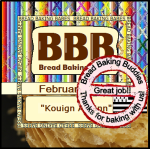



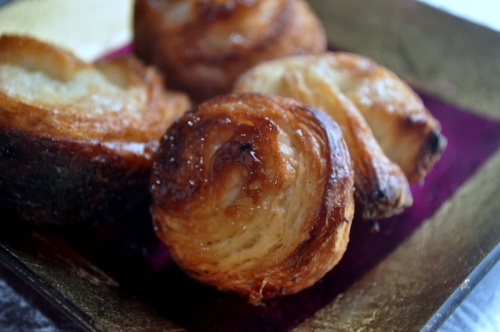
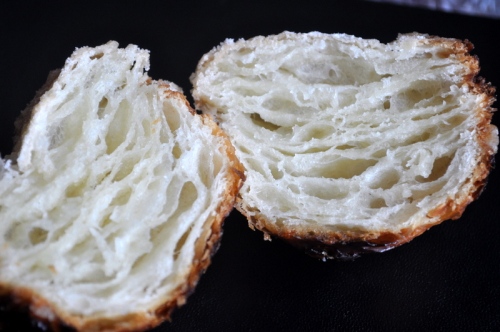
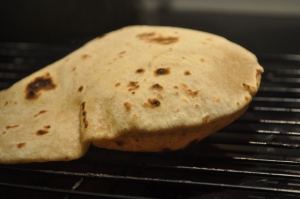
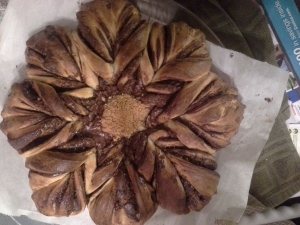
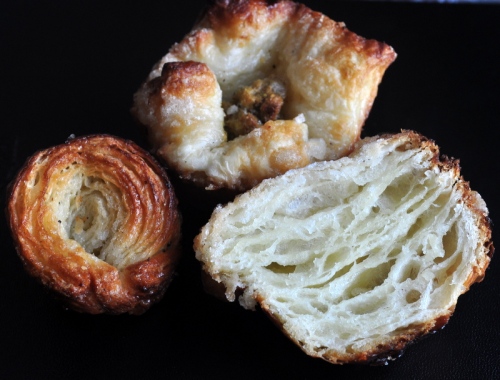
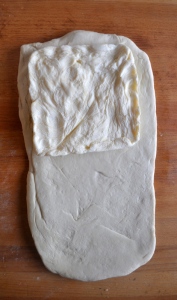
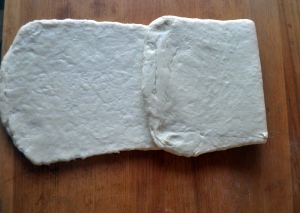
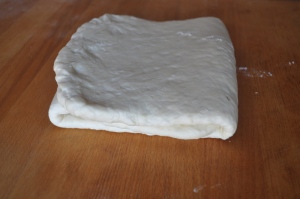

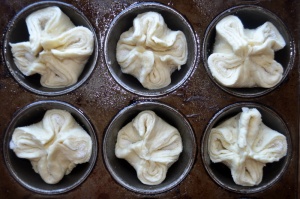

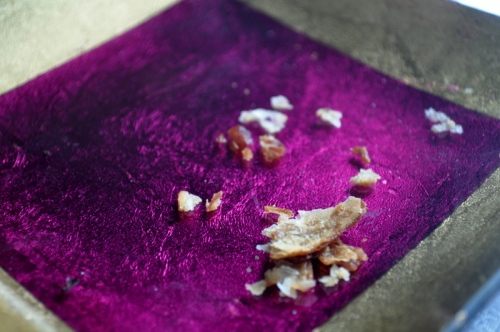
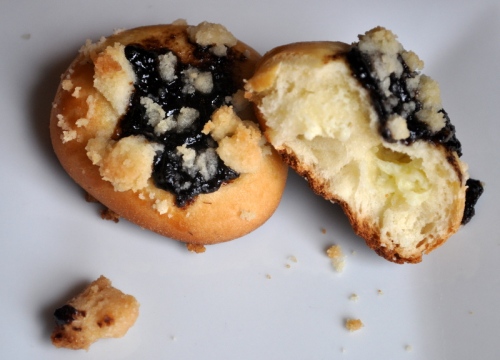
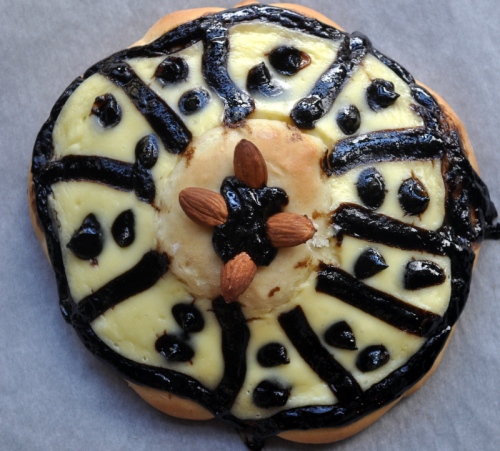
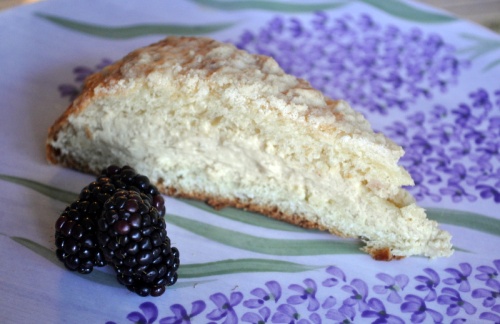
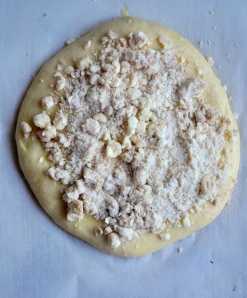

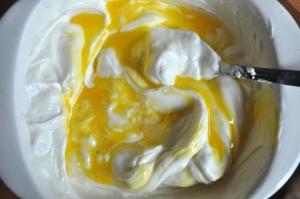

























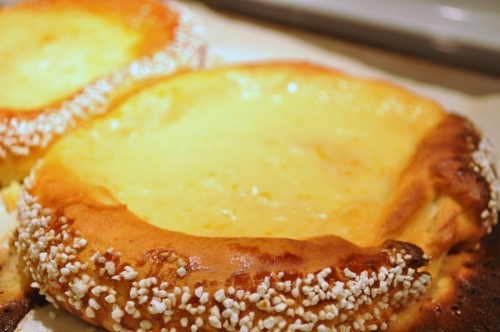
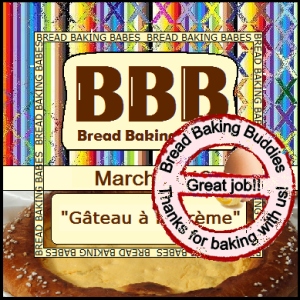
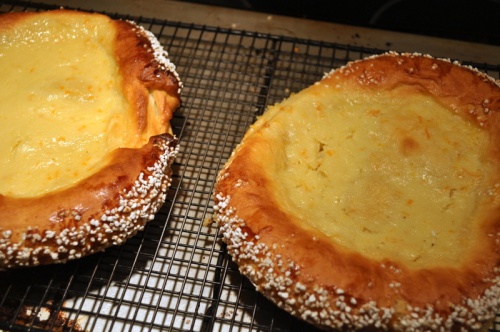

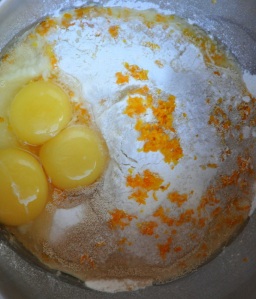
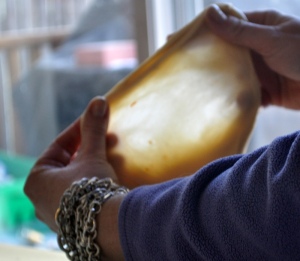
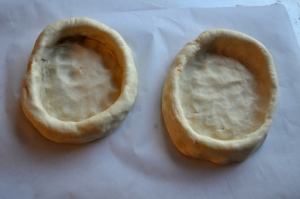
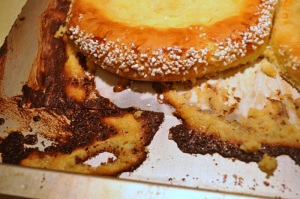






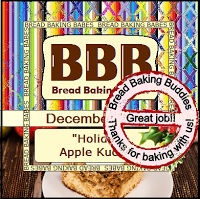
















 </a
</a
















